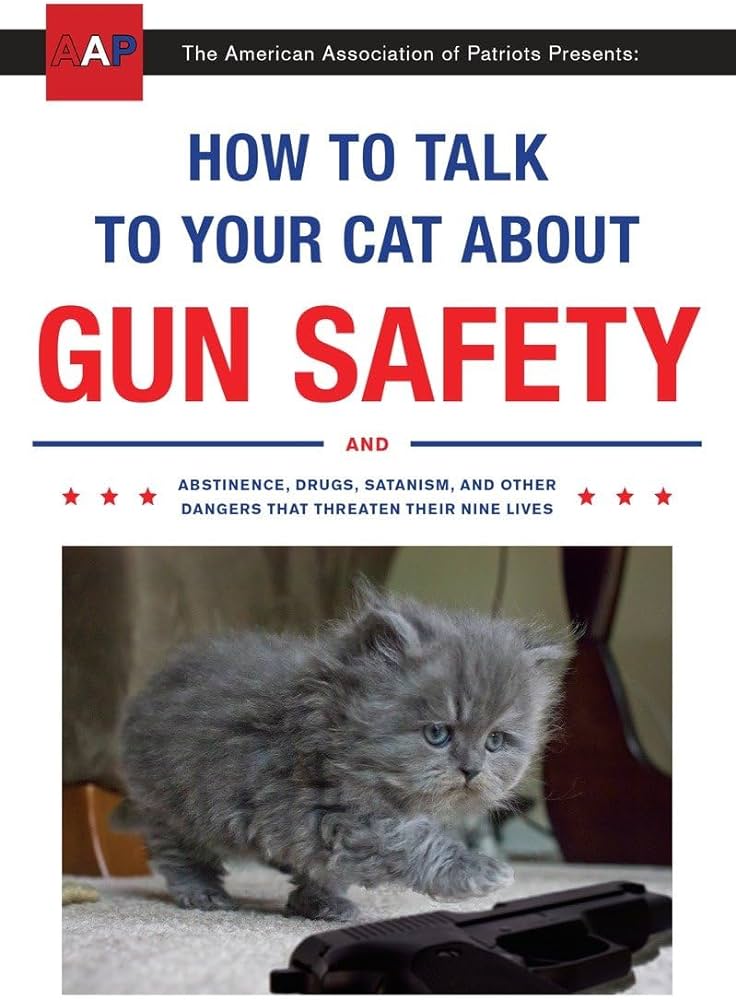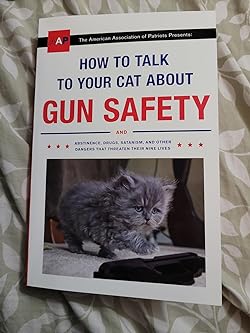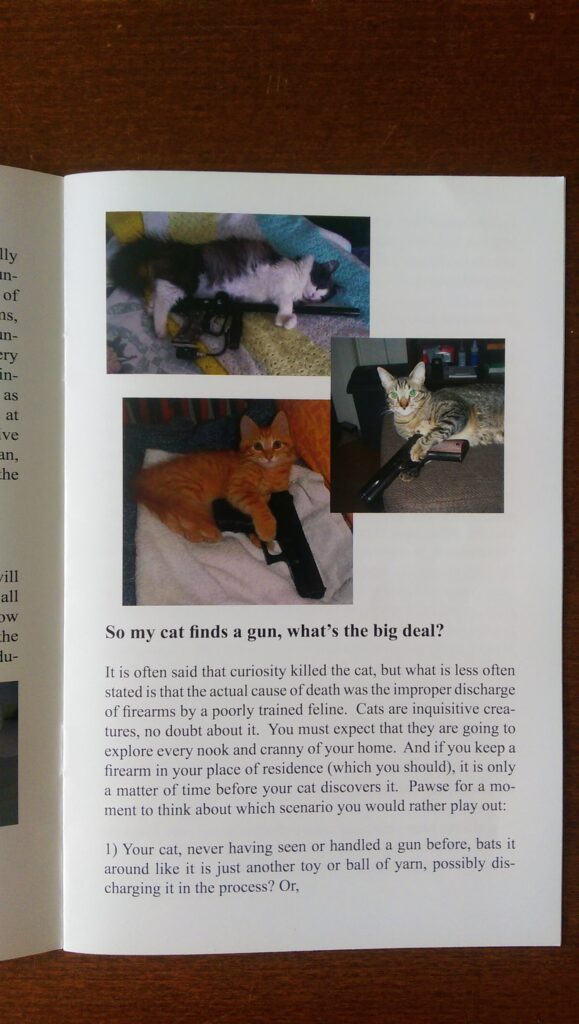Are you a cat owner who is concerned about gun safety? Look no further! In this article, you will discover an informative guide on how to effectively communicate with your feline friend about the importance of gun safety. By implementing these strategies, you will gain valuable knowledge on engaging in a friendly conversation with your cat, ensuring their wellbeing and fostering a safe environment for everyone. So let’s embark on this unique journey of fostering understanding between you and your cat on the topic of gun safety.
Understanding Your Cat’s Communication
Cats have their own unique way of communicating with their humans and other animals. By observing your cat’s body language, you can gain a better understanding of their moods and needs. Pay attention to their tail position, ear posture, and facial expressions. For example, a relaxed and loosely swaying tail indicates contentment, while an upright and puffed-up tail can signal aggression or fear. By becoming familiar with your cat’s body language, you can better respond to their needs and maintain a harmonious relationship.
In addition to body language, vocal cues also play an important role in cat communication. Cats use various sounds such as meowing, purring, hissing, and growling to express their emotions and needs. Each sound carries a different meaning, so it’s crucial to pay attention to the context and the tone of your cat’s vocalizations. For instance, a high-pitched and playful meow may indicate that your cat wants to play, while a low growl can be a sign of aggression or discomfort.
Knowing your cat’s routine and habits further helps in understanding their communication. Cats are creatures of habit and often follow a predictable schedule. Pay attention to their regular feeding times, playtime preferences, and sleep patterns. By understanding your cat’s routines, you can anticipate their needs and provide a safe and comfortable environment for them.
Establishing Trust with Your Cat
Building a strong bond with your cat is crucial to ensure their well-being and safety. Spending quality time with your cat is an excellent way to establish trust and deepen your connection. Engage in activities that your cat enjoys, such as interactive play sessions with toys or grooming sessions. By devoting time to your cat’s needs and desires, you show them that you value their presence and care about their happiness.
Practicing positive reinforcement is another effective method to build trust with your cat. Reward and praise them for positive behaviors, such as using the litter box, scratching their designated scratching post, or coming when called. This positive association encourages your cat to repeat these desirable behaviors and strengthens their bond with you. Remember to be patient and consistent in your approach, as it may take time for your cat to fully trust and understand your intentions.

Introducing the Concept of Gun Safety
When it comes to introducing the concept of gun safety to your cat, it’s essential to approach it in a way that they can comprehend. Using toys to represent the concept of guns can be a helpful starting point. Find toys that resemble guns in shape or sound and introduce them to your cat during playtime. This helps create an association between the toy and the concept of danger, laying the groundwork for further understanding.
Timing is crucial when introducing the concept of gun safety to your cat. Choose a time when your cat is relaxed and attentive, such as after a meal or during a quiet play session. Avoid introducing the concept when your cat is already stressed or distracted, as it may hinder their ability to understand and retain the information.
Before discussing gun safety, ensure that you have your cat’s full attention. Use their name and a soothing tone of voice to get their focus. Once you have their attention, proceed with the discussion in a calm and non-threatening manner.
Explaining the Dangers of Guns
To explain the dangers of guns to your cat, it can be helpful to relate it to noises that cats naturally dislike. Cats have sensitive hearing and are often startled by loud or sudden noises. Use this knowledge to explain that the loud noise of a gun can be harmful and dangerous. Emphasize the importance of staying away from loud noises to keep them safe.
Scent is another powerful tool to indicate danger to your cat. Cats have a highly developed sense of smell, and certain scents can serve as warning signals. Consider using scented toys or sprays that have an unpleasant or aversive scent to represent the danger of guns. By associating the scent with a negative experience, your cat can learn to avoid objects or areas associated with that scent.
In addition to sounds and scents, using toys can help demonstrate the physical harm that can be caused by guns. Find toys that resemble small projectiles or pellets and show your cat how they can cause harm. Allow your cat to explore and interact with the toys in a safe environment while closely monitoring their reactions. This visual representation can help them understand the potential dangers of guns.

Establishing Gun-Safe Zones
Creating designated gun-safe zones within your home is an important step in ensuring the safety of both you and your cat. Choose specific areas where guns and related accessories are securely stored and inaccessible to your cat. These areas should be off-limits to your cat and clearly marked with visual cues, such as signs or barriers.
Encouraging your cat to stay in these gun-safe zones requires positive reinforcement. Reward your cat for staying in these designated areas by providing treats, praise, or interactive play. Make these zones appealing by adding cozy bedding, toys, and scratching posts to create a comfortable and stimulating environment. By associating these areas with positive experiences, your cat will be more likely to stay away from potential gun-related dangers.
Teaching Your Cat to Stay Away from Guns
In addition to establishing gun-safe zones, it’s crucial to teach your cat to stay away from guns whenever they encounter them. One effective method is to use deterrent scents on guns. Cats have a strong sense of smell, and certain scents can be unpleasant or aversive to them. Apply scents such as citrus, vinegar, or bitter apple on and around the guns to discourage your cat’s curiosity. Be sure to research safe scents for cats and consult with your veterinarian if you have any concerns.
Discouraging curiosity towards guns also involves redirecting your cat’s attention to more appropriate activities. Provide alternative forms of stimulation, such as interactive toys, scratching posts, or puzzle feeders. By redirecting your cat’s energy and curiosity towards more suitable outlets, they will be less inclined to explore potentially dangerous objects like guns.
Rewarding avoidance behavior is another important aspect of teaching your cat to stay away from guns. Whenever your cat shows disinterest or moves away from guns, immediately reward them with treats, praise, or playtime. This positive reinforcement reinforces their understanding that staying away from guns leads to positive outcomes.

Training Your Cat to Alert You
Teaching your cat to alert you in the presence of guns can be a valuable safety measure. Start by associating a specific sound or behavior with the presence of guns. For example, train your cat to meow or behave differently, such as pawing or pacing when they encounter guns. Reward and praise them immediately for displaying this alert behavior. This training helps create an association between the presence of guns and the desired response from your cat.
Regular reinforcement is key to maintaining this alert behavior. Periodically repeat the training sessions to ensure that your cat retains the information and continues to respond appropriately. Be patient and consistent throughout the training process, as it may take time for your cat to fully grasp the concept and consistently alert you when guns are present.
Regular Reinforcement of the Concept
Reinforcing the concept of gun safety should be an ongoing process. Regularly repeating gun safety sessions is essential to ensure that your cat retains the information and continues to exhibit safe behaviors. Use positive reinforcement techniques during these sessions, such as rewards, treats, and praise, to reinforce the importance of staying away from guns.
Patience and consistency are crucial during the training process. Understand that learning takes time and that your cat may not grasp the concept immediately. By providing clear and consistent guidance, you can help your cat understand and internalize the principles of gun safety.
Reinforcing positive behavior with rewards is an effective way to encourage your cat’s compliance with gun safety guidelines. Whenever your cat exhibits safe behaviors, such as staying away from guns or demonstrating an alert response, reward them with treats, praise, or playtime. This positive reinforcement strengthens their understanding of what is expected and motivates them to continue exhibiting safe behaviors.

Understanding the Limitations of Your Cat
It’s important to remember that cats cannot fully understand the concept of gun safety in the same way humans do. While they can learn to associate certain cues and behaviors with potential danger, they may still be limited in their ability to comprehend the full implications of guns. Respect their limitations and continue to provide a safe environment by implementing the necessary safety measures to protect both your cat and yourself.
Understanding your cat’s instincts and behavior towards unfamiliar objects is crucial in maintaining their safety. Cats are naturally curious creatures and may approach unfamiliar objects out of curiosity. Ensure that guns and gun-related items are securely stored and inaccessible to prevent accidental encounters. Additionally, provide alternative sources of stimulation and enrichment to keep your cat engaged and content, reducing the likelihood of them venturing towards potentially dangerous objects.
Maintaining Human Responsibility
While it’s important to educate your cat about gun safety, it’s equally essential for humans to take full responsibility for gun safety in the home. Keep guns secured and locked away in a safe or gun cabinet that is inaccessible to both children and pets. Always ensure that guns are unloaded and properly stored with the necessary trigger locks or other safety devices.
Never leave your cat in a situation where they might encounter a gun unattended. When cleaning or handling guns, keep your cat securely confined to a different area of the house to prevent accidental exposure. Additionally, be mindful of any visitors or guests who may bring guns into your home. Clearly communicate and enforce your gun safety rules to ensure everyone’s well-being.
Remember, your cat’s safety is in your hands. By understanding their communication, establishing trust, introducing the concept of gun safety in a cat-friendly manner, and maintaining proper safety protocols, you can create a safe and secure environment for both your cat and yourself.

